Furniture / Meubles
Furniture and the Atlantic Canada Condition
Abstract
This paper looks at the place of furniture (as well as its indigenous fabrication) in the domestic environment, culture, and economy of eighteenth- and early nineteenth-century Atlantic Canada. Looking at the particular restrictions economy and climate set on producer and user alike, the paper examines the effect of these factors on the region's furniture.
Résumé
Cette communication étudie le rôle du mobilier, ainsi que les conditions de fabrication, dans la vie domestique, la culture et l'économie du XVIIIe siècle et du début du XIXe, dans la région de l'Atlantique. L'auteur étudie les restrictions particulières que l'économie et le climat imposaient au fabricant comme à l'usager, et examine l'effet de ces facteurs sur le mobilier de la région.
1 In deciding to discuss furniture and the Atlantic Canada condition, I have deliberately chosen a rather large topic. I will attempt to describe, in a general way, how the pre-industrial furniture of this region reflected all the special conditions of its times and environment rather than simply those of prevailing fashion and taste.
2 Over a goodly number of years of observing and recording the domestic baggage of earlier ages, as well as focusing on furniture and ceramics, I have become convinced that furniture and other surviving objects are every bit as much messengers from the past as are books, documents, and pictures. Pieces of early furniture in particular are not just antiques with a certain market value this year and sure to be worth more next. Instead they are messengers which when looked at singly, or preferably in some numbers and then compared, offer clues and insights into their own times which might otherwise be missed. Most particularly, furniture offers indications of local economies, of the strength of tradition against pressures of fashion and change, of peoples' reactions to the imperatives of climate, and of individual ingenuity.
3 In spite of glossy tourist advertisements and folders, with their photographs always of placid, sunny days, Atlantic Canada always was and remains today, in geography and climate, one of the physically more inhospitable regions of the world. It is agriculturally marginal, surrounded by cold and dangerous North Atlantic seas, and is subject to rains and fogs, gales and blizzards. It is not and never was a region of easy or comfortable human existence, and there is no escaping that fact. This must simply be accepted as having a certain effect on the populace and, since domestic amenities are the products of people, also an effect on what they produced or could (or would) use. Climate is inevitably reflected in furniture types, as well as in the characteristics of individual pieces.
4 Then we have the population — the Europeans who first, and for generations following, inhabited this land. Atlantic Canada was an extremely difficult area to settle and populate successfully, since almost total outside support and supply was the initial requirement though it was never given. Aside from purely exploratory expeditions, all attempts to establish permanent settlements, from the Fagundes Portuguese settlers of 1522 on Cape Breton Island to Mesgouez 1598 colony on Sable Island failed until the seventeenth century. It was the French who first settled Acadia, Prince Edward Island, and Cape Breton Island, while the English, a century later, settled southern Nova Scotia and the Bay of Fundy area. Both were, by the early eighteenth century, backed by treaties, navies and forts.
5 We have few good descriptions of domestic existence in Atlantic Canada during the French period, and none of the copious sources such as property transfers, contracts, litigation records, and probate inventories that survive in archives in Quebec. Life was undoubtedly primitive, hard, and short in the isolated farming and fishing settlements of Acadia and Cape Breton. These were not a literate or literary people, and little but untouched, remote, and scrub-covered archaeological sites have come down to us.
6 So far as domestic amenities were concerned, I have never seen or heard of a surviving example of Acadian-made furniture dating from the pre-1745 period, or of any surviving piece of Cape Breton French-made furniture, or any other material remains for that matter. I suspect that such pieces do not exist, and probably little ever did in the sense of what we would today consider furniture.
7 The same is true of pottery, which even beyond furniture was an absolute essential of any domestic establishment. Simple earthen pottery of natural clay was cheap, replaceable, and used in every aspect of food storage and preparation. I have also, however, never seen the slightest evidence of indigenous pottery in Atlantic Canada before the early nineteenth century, and little seems to survive from much before 1860.
8 What do we find instead? From Louisbourg has emerged a most varied range of eighteenth-century French earthenware along with scatterings of English and Massachusetts wares, but nothing remotely local. Seventeenth-century Spanish and other Mediterranean pottery is occasionally recovered off Newfoundland and Nova Scotia. My wife and I have explored the French brickyard on the Mira River, against perhaps the world's most ravenous mosquitoes, hoping that this eighteenth-century ceramic-material site, the only one known, might have made occasional pottery as well. Brick fragments we found in profusion, but not a single potsherd.
 Display large image of Figure 1
Display large image of Figure 1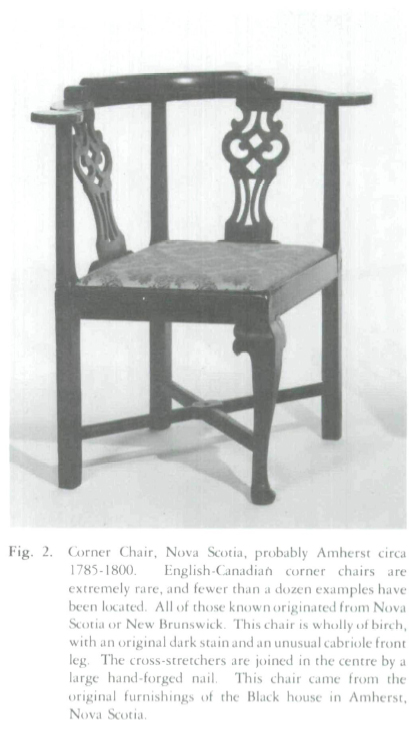 Display large image of Figure 2
Display large image of Figure 29 Simple French green glazed earthenware erodes from the shorelines at Igonish (the French Niganiche) and St Peter (Port-Toulouse). It is found in freshly turned gardens at Englishtown (Port-Dauphin). In areas where later anglophone settlement was superimposed over the French, we find evidence in sherds of late eighteenth-century English ceramics mixed with the French, but still not a trace of local pottery production.
10 In any event, though they were then British citizens, the Acadians in 1755 were largely forcibly removed south to the American colonies. Many later returned. The Cape Breton and Prince Edward Island settlements were destroyed twice, after 1745 and 1760, and their populations transported to France. Aside from the broader military aspect and the Fortress of Louisbourg, thorough and detailed knowledge of a century and a half of French habitation of Acadia, P.E.I., and Cape Breton is limited.
11 After many abortive attempts, the period of secure English settlement of Atlantic Canada came only with the treaty of Aix-la-Chapelle, which was, in hindsight, a temporary truce that in October 1748 ended what was known in the English colonies as King George's War. New Englanders, of course, were bitter over the return of hard-won Louisbourg and Cape Breton to the French as a tradeoff for Madras in India, for they thought it would sooner or later have to be taken again.
12 We are not really concerned here, however, with colonial trade-offs or the negotiations of distant kings, but with the actual conditions of people living in the areas affected by larger events. There is little doubt that the treatment of the French population in 1755, and for a decade after, if not quite modern genocide, was little short of it. With the burning of farms and homesteads and the forcible removal of local populations, it is little wonder that almost no French-derived furniture or French-period architecture survives in Atlantic Canada.
13 Repopulating began immediately. The English had already established Halifax in June 1749 with the Cornwallis expedition, 2,500 strong. German settlers founded Lunenburg in 1753. New England settlers moved into the Annapolis Valley, depopulated by the Acadian displacements, in the 1760s. The beginnings of the Scottish migrations in the 1770s resulted in the settlement of Pictou in 1773 and were the first wave of a great exodus that continued for nearly a century. Finally in the 1780s came the Loyalist migration to Nova Scotia and New Brunswick, resulting in the founding of Saint John and dozens of other towns.
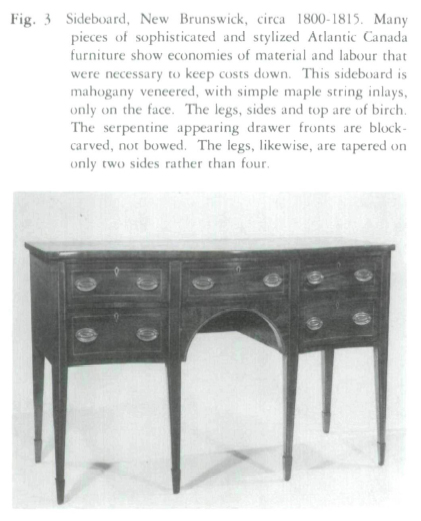 Display large image of Figure 3
Display large image of Figure 314 Until the heavy population influxes of the 1780s, all present evidence suggests that the French and later Scottish and Loyalist populations were heavily and perhaps absolutely dependent for even the simplest amenities on supplies and importations from overseas. While plain wooden furniture and implements, from chairs to agricultural tools to spoons or dishes, could be made by the settler, more specialized necessities, such as window glass, pottery, glassware, and iron tools and hardware, could not. All these essentials to domestic existence required craftsmen and manufacturing.
15 There is, however, no knowledge of any such craftsmen operating in Atlantic Canada before the mid-eighteenth century. Even from that period virtually nothing reflecting any of the specialized crafts was locally produced except for simple furniture as an off-shoot of basic carpentry. Had there been other local crafts, some archaeological traces would certainly appear, but they have not so far. I would expect to find these traces even where specific types of objects, such as pottery, have not survived intact.
16 Edward Draper, listed as a cabinet-maker, arrived with the Cornwallis settlers at Halifax, making him the first known cabinet-maker in Atlantic Canada. No surviving pieces can be attributed to him, but the furniture produced by Draper and other carpenters and shipwrights was probably as basic and utilitarian as that of the early Acadians.
17 Cabinet-making as a fine craft resulting in sophisticated and stylized furniture did not begin to emerge until the 1780s. Even then, few cabinet-makers were in business and little in the way of stylized furniture was actually produced before the nineteenth century. Those recognized at present as leading makers, such as Tulles, Pallister & MacDonald, Robert Chillas, Thomas Nisbet, Alexander Lawrence, Daniel Green, and so on, were to emerge only later.
18 There were good reasons for this slow development. First, the people of Atlantic Canada in the last decades of the eighteenth century were a refugee population in the sense of having lost the option of staying where they were. From Loyalists to Protestant Germans to displaced Scots to returning Acadians, these people came to Atlantic Canada out of necessity rather than real choice; often bereft of possessions, they had to build new lives from the bottom.
19 They arrived, many illequipped by temperament or experience, in a region with a difficult climate and without a pre-existing economy or infrastructure of trades, crafts, merchants, and services. Such an economy had to be created, a process that took decades. Meanwhile, except in the centres of Halifax and Saint John, which had the economic benefits of military garrisons and mercantile activity, the domestic norm was bare subsistence from farming, fishing, or logging, with habitation in simple log or framed houses. There were exceptions, to be sure, but generally first-generation pioneering meant a level of poverty and privation almost beyond present-day comprehension.
20 To these settlers amenities such as stylized furniture, or anything beyond what they could make themselves or barter for, was unimaginable luxury. There was no market here for such non-essential specialist craftsmen as cabinet-makers, any more than there would have been for silversmiths.
21 In the cities and larger towns the situation was somewhat different. With populations that included wealthier urban Loyalists, an English and Scottish mercantile group, garrisons, dockyards, and overseas shipping and trade, the cities of Halifax and Saint John in particular rapidly developed the conditions attractive to cabinet-makers and other specialized artisans — interdependent economies and population bases sufficient to provide reasonable outlets for their talents.
22 Cabinet-makers and other craftmen in Atlantic Canada and elsewhere, however, faced some pervasive difficulties. The prosperous population that was their natural clientele generally saw Britain or New England as home, and Atlantic Canada merely as where they were. If one needed furniture, the strong tendency was to order it from England or Boston or deal through an importing merchant. In the initial generations of settlement these people were hesitant to commission furnishings from local makers, and the ingrained "British is better" feeling was slow to die out.
23 The sparsity of early indigenous furniture production is borne out by the extreme rarity of surviving examples. I would be hard pressed to think of as many as ten pieces of stylized and sophisticated Atlantic Canada furniture that I would reasonably date as earlier than 1800. Many hundreds of good pieces, however, still survive from twenty or thirty years later. Fires alone cannot account for that survival differential.
24 Mahogany was the favoured cabinet wood of the Georgian period, and it was used by the best Atlantic Canada cabinet-makers, as well as by those of Britain and the coastal United States. The figures for importation of West Indian mahogany from the Accounts Relating to the Trade and Navigation with the British North Americaan Colonies (L800-14) are also revealing. Nova Scotia imported just 1 mahogany log in 1800, 22 in 1801, none from 1802 to 1808, then 32 in 1809, 66 in 1810, and fewer in the years to 1814. The first recorded 5 logs came into New Brunswick only in 1812, and 2 were brought in 1814. Newfoundland imported just 300 board feet of mahogany in 1814, and Prince Edward Island figures show no mahogany imports at all during this period. These figures are confirmed by the appearance of Chippendale-style furniture in mahogany from Nova Scotia, but not elsewhere.
25 The heaviest wood imports were, in fact, dyewoods — logwood, fustic, Braziletto, and Jaragua — as well as lignum vitae for tools and wearing parts. Even if one adds an unrecorded smuggling factor of as much as three to one, these mahogany imports still do not indicate a large furniture-making trade before 1815.
26 Beyond the pervasive "British is better" syndrome, cabinet-makers and other material producers also faced increasing and unbeatable English competition. Colonial mercantile policy held that colonial populations should be producers of raw exports — salted fish and lumber from Atlantic Canada — and provide a captive market for home-country manufactures. In no way, should a colony be allowed to become self-sufficient in manufactures. France in the seventeenth and eighteenth centuries took a meat-axe approach, prohibiting or severely restricting through licensing many productive crafts, though not cabinet-making. While it protected the market, on occasion desperate situations arose when supply ships failed to arrive from France on time, or at all.
27 The British method of market control was more modern but nearly as effective — unrestricted economic dumping by British industries, without colonial duties to encourage and protect indigenous producers. Dumping was particularly blatant in ceramics. Shiploads of English pottery would show up to be auctioned on the docks at prices well below what any small-scale local potter could hope to match. Dumping of ceramics, in fact, sufficiently monopolized the market as to prevent the establishment of a pottery industry in English Atlantic Canada for fully a century.
28 The same situation could not, of course, apply to furniture, for furniture was a handmade rather than manufactured commodity. Much of the population provided its own furniture anyway, and local carpenters and shipbuilders made more, often in trade for lumber or farm produce. No threat of imported competition could touch that do-it-yourself or barter economy. As a result, the specialist urban cabinet-makers, working in imported hardwoods, found their clientele only in the wealthier segments of the population — a limited market. The capacity of this market was further restricted by access to imported furniture, furniture that might well be considered more desirable.
29 For this combination of economic and cultural reasons, cabinet-makers were forced to adapt from and simplify English and American styles, trying to maintain substance — fashionable design and good proportion — but cutting down on time-consuming and expensive elaboration and ornament. Thus we find little furniture of the 1780-1820 period with elaborate inlays or marquetry, and nothing really equivalent to the finest work of the American Atlantic seaboard makers, much less the opulence of the finest English furniture. The new Canadian seaboard population had not yet developed the wealth to afford such pieces, and few people had the houses to complement great elegance.
30 In even the best furniture of Atlantic Canada, as a result, we find all manner of economically determined shortcuts. Most typically, for example, single line or string inlays, generally of maple in contrast to mahogany, were the maximum ornamentation. We do not find the complex swag, bell-flower, or motif inlays of New England urban furniture of the same period. Elaborate carving or evidence of complex techniques, such as steam bowing of serpentine drawer fronts, is unknown.
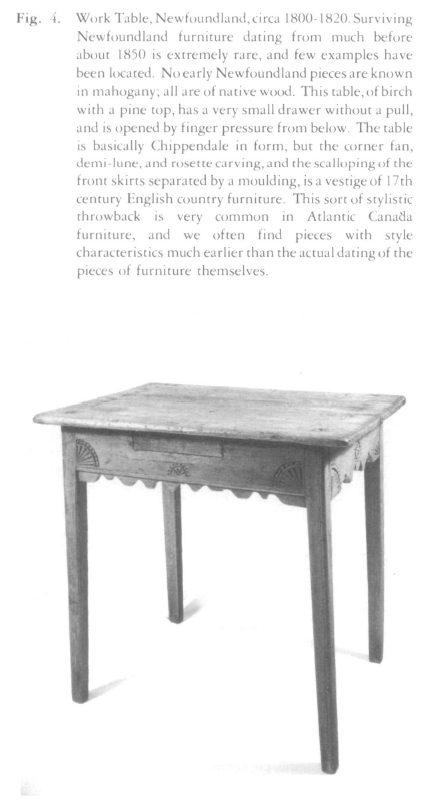 Display large image of Figure 4
Display large image of Figure 431 Input cost was kept to a minimum; this is clearly evident in any examination of surviving furniture. Veneers were applied only where essential, most usually over secondary pine of drawer fronts, since veneers were imported pre-cut and bundled, and were expensive. Solid wood was preferred, as cheaper and easier to work with, wherever possible. Often mahogany was used only for the facing or fronts of furniture, with lesser native woods, typically stained birch (the poor man's mahogany) substituted for sides and tops. The same cost shaving applied to brass hardware which, though universal on sophisticated English and American furniture, was often skipped in Atlantic Canada before the 1820s in favour of plain but matching wooden knobs.
32 Labour and time saving are also commonly evident in the use of butted joints as opposed to dovetailing and in pinned structural connections as opposed to those tightly fitted and glued. For the legs of chairs and case pieces, plain round lathe turnings predominate, sometimes incongruously with basic design, while more laborious shaped or reeded legs are scarce.
33 The influences of the regional groups who predominated in the late eighteenth-century Atlantic Canada mosaic are also quite evident in much of the furniture produced. There is at present no complete record of cabinet-makers and their origins and training, and little extant furniture can be attributed to specific makers. Still, distinct minor style, proportion, and construction details and characteristics sometimes indicate the origins of makers, for the area of their apprenticeship training shows through in their work.
34 Though this is based only on observation of surviving furniture, it would appear that, at least in the Maritimes, Scottish-trained makers predominated numerically, while American furniture styles were the dominant taste. Cabinet-makers, of course, had to build what their customers wanted, since they worked to order and rarely made furniture on speculation. Thus a Scottish maker working in a Loyalist area, or for a largely Loyalist market, could and would adapt to New England forms. These forms would be governed by what the customer could afford, but the maker's Scottish origin would still be evident.
35 Perhaps the best example of this dominance of American forms is the Windsor chair, an infinitely variable spindle-backed chair which has been a British and North American favourite from the early eighteenth-century to the present. The British Isles form generally has a vertical, central, pierced backsplat, flanked by spindles on either side, while the American form has a back fully of vertical spindles. In Atlantic Canada only the American form emerged, and it was produced by numerous makers and factories beginning with that of Joseph DeGant, opened in Halifax in 1780. I have never seen a Windsor chair of the English type identifiable as of Atlantic Canada origin.
36 The climate also has a distinct effect, not as much on styles and design forms, for these followed prevailing English and American fashion and traditional styles, as on the range of furniture types and relative quantities produced. Most houses were small, with a single central or end-wall chimney and a single fireplace used for both cooking and heating. The more fortunate, in houses with two rooms down and two rooms up, had back-to-back fireplaces on the first floor. With such inefficient and ineffective heating, winter was a season of cold and misery, and often of sickness and death. Coffin-making kept the carpenters busy. Families essentially wintered in their kitchens and rushed into freezing bedrooms only to leap quickly under the covers at night.
37 Under these conditions, most furniture was simple, utilitarian, and multi-purpose — large kitchen tables, corner or wall cupboards, hard benches or perhaps ladder-back or Windsor chairs, chests of drawers, and storage or blanket boxes. The roster might also include candlestands, small work or sewing tables, and drop-leaf tables which could be stored against a wall. This list also happens to comprise exactly those furniture forms which still survive in the greatest quantities, most of designs and native woods that antiquarians today view as "country" rather than stylized or formal. This was the furniture in most general and widespread use.
38 Fires have certainly taken a major toll over the centuries, so we have no really valid idea of actual survival percentages. Certainly they are small. Fires were either random or general but not selective, however, so we must presume that the amount of various furniture types surviving probably reflect approximately the relative quantities of each type originally produced.
39 The more stylized and sophisticated furniture, the product of the specialized cabinet-makers, was always in the minority. Some furniture types, which were quite unnecessary in the average unheatable house, are relatively scarce today, since they were originally made only in small quantities. I think here of specialized hall, parlour, dining-room, office, or guest-room furnishing, furniture necessary more for social or image reasons than for daily use. Large sectional dining-tables and sets of chairs, sideboards, hallway mirrors, side-tables, tall clocks, desks, glazed cupboard-bookcases, folding game-tables, upholstered chairs or sofas, sofa tables, corner chairs, wine cellarettes, and other forms fall into this category of special and, for the most part, single-purpose furniture. Such surviving furniture is virtually all formal and stylized, generally in mahogany though sometimes of birch or maple.
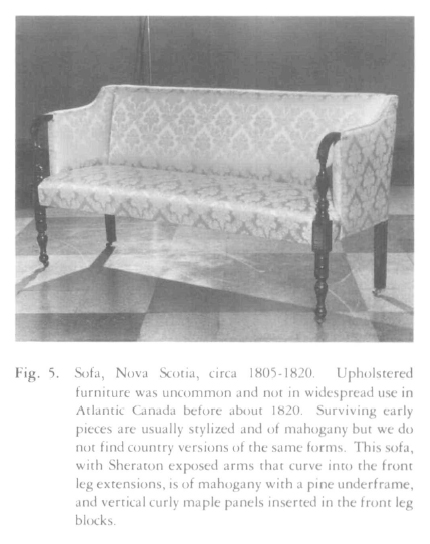 Display large image of Figure 5
Display large image of Figure 540 Though there are exceptions, many of these types all but do not even exist in "country" or basic carpenter-made forms. The reason is that special-purpose furniture was justified and useful only in houses that were fully habitable in winter, large houses with multiple heating sources — multiple fireplaces in end-wall chimneys. Such houses were few, and belonged to people who could afford to counter, at least somewhat, the rigours of winter and to patronize cabinet-makers, as opposed to local carpenters.
41 Domestic life even as late as the first two decades of the nineteenth century was, by any measure, generally uncomfortable. This lack of comfort was a product not only of climate, but also of furniture design. While chairs were an improvement over stools, they still only supported weight and hardly conformed to the human spine Upholstered furniture was a rare and luxurious possession before 1810 or so, and existing chairs, sofas, or day-beds from hi fore about 1820 are quite scarce. They did not, in fact, come into general use until about the mid-1830s.
42 In the years following the end of the Warol 1812, we can clearly see, just in furniture, the beginnings of a definite economic upswing, not only in the cost-base of input into stylized furniture, but particularly in the quantities of it being made. This happened to coincide with the general introduction of enclosed iron stoves, which for the first time made any house fully heatable and habitable in winter, and the rapid decline of the age-old but grossly inefficient fireplace. Judging just from surviving quantities, the amount of furniture being produced by the period 1825-30 seems to have increased ten-fold over 1810, and a part of this change is certainly attributable to the improved heating and usability of houses.
43 Fashions were changing as well, and the basic English Georgian furniture designs were giving way to the Americanized French empire style, which was to remain the dominant fashion for thirty years. Inlaying declined with the decline in popularity of the English styles, and carving increased with the empire.
44 Technology and machinery developed rapidly in the 1820s and 1830s, as did power systems and mechanization. By 1825, for example, both veneers and hardware had become much less expensive and more readily available through the introduction of the continuous-cutting circular saw and metal-pressing and stamping machines. Thus veneering increased on furniture, and brass hardware became general rather than the exception.
45 At the same time, we see the beginnings of homogenization of taste and fashion throughout North America, and the gradual disappearance of regional characteristics and distinctions. This homogenization was pushed in no small way by the practical imperatives of adapting furniture design to the productive capacity — and limitations — of machinery. As steamships and railroads made personal mobility ever more possible and available, this process accelerated until by the 1850s there remained little substantive design difference between furniture produced in Halifax and that made in Cincinnati. By then it no longer reflected applied arts and individual skills, but factories and marketing instead. However, the rise of technology and mechanization, and the decline of the individual crafts, is a complex story and not one for me to get deeply into here.
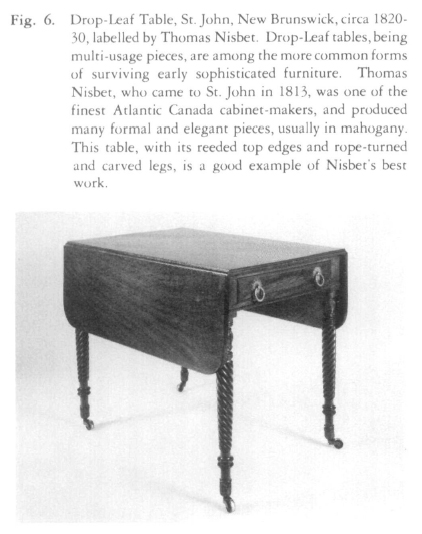 Display large image of Figure 6
Display large image of Figure 646 If I can make any single point, I think it must be that Atlantic Canada's early furniture, or any of the decorative arts, cannot be viewed just as isolated antiquities of certain ages and current values. It should instead be compared to the whole range of surviving examples of its place and time. That range of furniture then should be looked at as the art of the possible for its own time and place, considering all of the various constraints that are reflected in it.
47 The undeveloped economy of these Atlantic colonies, for example, could not accommodate truly opulent furniture of the type being made in the older and wealthier American seaboard cities, so it was not produced. The cabinet-makers instead leaned to design adaptation and simplification; there is no extravagance in this furniture.
48 The taste and preference for basic English, Scottish, and American Georgian forms was governed by the users, not the producers. Unlike the fashionable cabinet-makers of England or of Boston and New York, Atlantic Canada cabinet-makers had no definable impact or influence on fashion and taste. They were interpreters rather than creators of fashion. Thus we do not find experimentation or new design initiatives on the part of these makers, and they could probably not have marketed such innovations to their conservative clientele.
49 Climate prevented the widespread use of many forms of specialized furniture, resulting in great differences in surviving quantities of various furniture forms. The introduction of enclosed cast-iron stoves, which made more rooms usable, probably had a greater overall impact on cabinet-making than the introduction of any of the new machinery.
50 Furniture in Atlantic Canada, as one of the highest of the applied arts, was in a sense a mirror of everything else that affected life in those times — the geography and climate of the land, national and ethnic origins of the people, the economy and the acquisitive capacity of the market, the availability and costs of materials, and the technology and productive capacity of the crafts. There is no way of separating furniture from these and other factors.
51 The picture is beyond doubt extremely complex, and from furniture alone at this remove we can define only basic messages and conclusions — generalities. When furniture and other decorative arts are examined broadly and analysed in detail, however, we can still extract history of a sort that was not often recorded in documents but that can give us an accurate picture of domestic life in particular periods and situations.